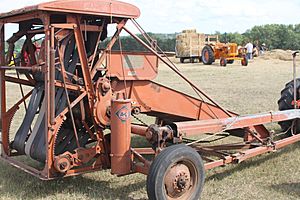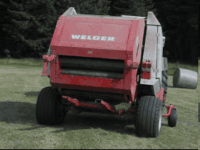Baler facts for kids
A baler, often called a hay baler, is a special machine used on farms. It helps farmers gather and squeeze cut crops like hay, straw, or cotton into tight bundles called bales. These bales are much easier to move, store, and transport.
Bales are designed to keep the plants fresh and nutritious. There are different kinds of balers. They make bales that are either rectangular or cylinder-shaped. These bales are then tied with twine, netting, or wire to hold their shape.
Big balers are also used in recycling centers. They press metal, plastic, or paper into bales. This makes these materials easier to transport for recycling.
Contents
History of Balers
Before the 1800s, farmers cut hay by hand. They would pile it into large stacks called haystacks. These stacks helped the hay dry and cure. This kept the hay nutritious for animals later on.
In the 1860s, new machines were invented to cut crops. From these, modern mowers and balers were developed. In 1872, Charles Withington invented a machine that could bundle and tie hay. Cyrus McCormick started selling this machine in 1874.
Later, in 1936, a person named Innes invented an automatic baler. This machine used twine to tie the bales. An improved version was patented by Ed Nolt in 1939. His design was more reliable and became very popular.
How Round Balers Work
Today, the most common type of baler in many countries is the round baler. It makes cylinder-shaped bales, often called "round" or "rolled" bales. These bales are good because their shape helps rain run off, like a thatched roof.
Inside the baler, rubber belts or rollers roll the grass. This makes the bale bigger and bigger. Once the bale reaches the right size, netting or twine is wrapped around it. This keeps the bale together. Then, the back of the baler opens, and the round bale rolls out.
Sometimes, these bales are wrapped in plastic. This can keep hay dry when stored outside. It can also turn damp grass into silage, which is a type of fermented feed for animals.
Sizes of Round Bales
Large round balers make bales that are usually 48 to 72 inches (122 to 183 cm) wide. They can be up to 60 inches (152 cm) tall. These big bales can weigh from 1,100 to 2,200 pounds (500 to 1,000 kg). The weight depends on their size and how much moisture is in the hay.
Smaller round balers, sometimes called "mini round balers," make bales that are about 20 to 22 inches (51 to 56 cm) wide. They are 20.5 to 28 inches (52 to 71 cm) tall. These smaller bales usually weigh between 40 to 55 pounds (18 to 25 kg).
History of the Round Baler
The idea for a round baler came from Ummo Luebben around 1910. But the first round baler wasn't made until 1947. This was the Roto-Baler, introduced by Allis-Chalmers. It was popular because its bales shed water well and were lighter. By 1960, almost 70,000 units were sold.
A big step forward happened in 1965. A student named Virgil Haverdink and a professor, Wesley F. Buchele, at Iowa State University worked together. They designed a new large round baler. It was finished and tested in 1966. This design made large round bales that were about 5 feet (1.5 meters) wide and 7 feet (2 meters) long. They weighed about 600 pounds (270 kg) when dry.
Iowa State University explained that this invention helped farmers a lot. It saved them from the hard work of lifting small hay bales. The large round baler became the main machine for handling hay in the United States.
In 1969, the Australian Econ Fodder Roller baler came out. It made a 300-pound (135 kg) bale by rolling it on the ground. In 1970, The Hawkbilt Company started making large round balers based on Dr. Buchele's design.
In 1972, Gary Vermeer designed and made a round baler. His company, Vermeer Company, started selling its model 605. This was the first modern round baler that used belts to pack hay into a cylinder shape, like we see today. By 1975, many companies in America and Canada were making large round balers.
Images for kids
-
Large rectangular bales in a field in Charente, France. Stacking hay bales needs care. The drying process creates heat, and too much heat can cause fires. Stacking bales too wide or too high increases this risk.
See also
 In Spanish: Empacadora para niños
In Spanish: Empacadora para niños










